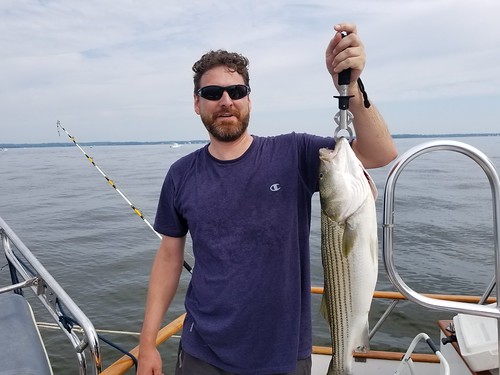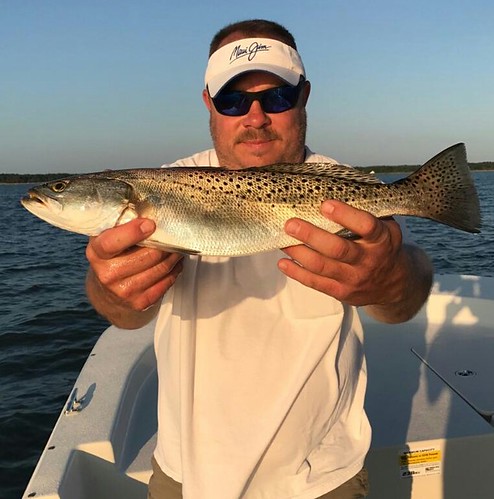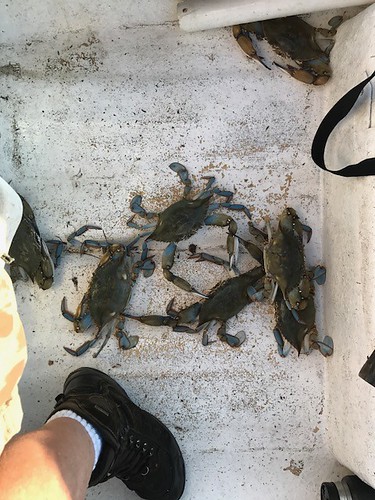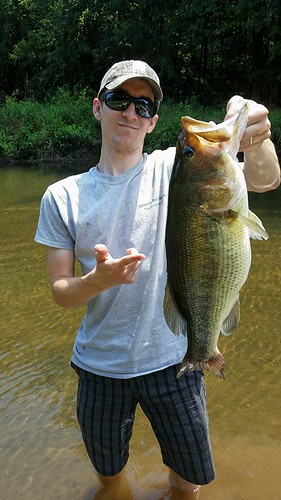Weekly Fishing Report: July 12

Jonathan and Daniel Irons got to go fishing with their dad and grandparents and caught this nice group of striped bass and a catfish; by Mike Irons
Fishing is one of those activities that is often so much better when shared with family and friends; memories of those adventures together can last a life time. Recently Jonathan and Daniel Irons got to go fishing with their grandparents that were visiting from Pennsylvania and with dad at the helm they had a rewarding trip that goes far beyond the bountiful catch of striped bass on that day.
In the far upper reaches of the Chesapeake Bay, there continues to be an early morning topwater striped bass bite around the edges of the Susquehanna Flats. Poppers tend to be the best lures to use and the best fishing is usually before the sun clears the horizon. In the Susquehanna River the best action is at the Conowingo Dam pool at sunup. Casting heavy swimshads into the boiling water during early power generation has been accounting for some nice striped bass catches. Channel catfish can be found in the lower river and upper bay channels.
Striped bass fishing in the upper bay could hardly be any better since large numbers of striped bass has moved into the upper bay in the past month. Chumming is perhaps the most popular way to fish and Swan Point, Love Point and Podickory Point are the locations to be. Most are finding it is imperative to locate a school of fish that are suspended along channel edges and then begin chumming on top of them. Adding a few small chunks and working to get the chum down to the fish goes a long way. The largest fish are being caught on the bottom at the back end of the chum slicks. The throwback ratios are still high, but manageable if care is taken to avoid deep hooking and careful releases.

Brian Harmon enjoyed great success while chumming at Swan Point and holds up a nice striped bass that he caught; by Brian Harmon
Trolling is a good option if lures get down to where the fish are holding. Bucktails dressed with sassy shads or twistertails are a good option as are surge tube lures (hoses) and parachutes behind inline weights. Salinities are rather low in the upper bay due to last week’s heavy rain so that may hold back the bluefish for a bit, but when they show up, soft plastic lure dressings will take a beating.
Jigging can be productive when a good concentration of fish can be spotted suspended under breaking fish or just holding on a channel edge. A variety of jigs will work but pink and pearl colored soft plastics have been a favorite, especially at the Bay Bridge piers and rock piles. Some of the best jigging action at the bridge has been occurring in about 35’ of water. White perch are holding in some of the same areas. Some anglers have been ferrying live spot up from the lower bay this week and we all know they are candy to striped bass and well worth the effort to bring them up if you have the means. Drifting the tried and true small live eel near the piers or rock piles will always work also.
White perch fishing on some of the knolls and shoal areas out in the upper bay have been good for those fishing with bottom rigs and bait. The tidal rivers and places like Kent Narrows also offer fishing opportunities for white perch.
Water temperatures in the middle bay region are holding just above 80 degrees this week and the salinity of the bay and tidal rivers in all regions of the bay are depressed due to last week’s heavy rains. There continues to be chumming for striped bass at the outside edge of Hackett’s Bar along the 30 foot contour but it is not at the level it was last month. Those that do not wish to make the trip to the upper bay region have been poking around the shipping channel edges looking for suspended fish to set up on. The outside edge of the Hill, the Clay Banks and the Diamonds are places that are worth a look. Bluefish should starting to filter into the middle bay region shortly and will provide additional fishing action.
Trolling along the steep edges of the shipping channel on both sides of the bay has been producing striped bass. Most are trolling a mix of bucktails, parachutes and surge tube lures all behind inline weights or planers. Umbrella rigs can be worth the effort also, but the important thing is to get down to where the fish are holding. It pays to keep an eye on depth finders when trolling near the mouth of the Choptank and Severn Rivers; you might stumble upon a ballast stone pile. These piles will often hold a half dozen striped bass and worth a few passes when trolling.

Greg Folk enjoyed a great day while trolling with an old Penn Senator reel that his grandfather gave him and caught this nice striped bass to get that reel back into action once again.
Jigging can be effective when suspended fish can be found. There is some bait in the form of bay anchovies in the middle bay region and the two and three year old striped bass have been working them over when their paths cross. As most know larger fish can be found at times under the surface action. It is always a good idea to check out slicks and gulls sitting on the water also. An enterprising few have been bringing live spot to the game and scoring on some nice striped bass. It tends to take longer to find a few baits then to find the striped bass that enjoy these tender morsels. Some are making the run down to the Patuxent River for live spot and others are finding a few in the middle bay region tidal rivers. It is hoped that more spot will move north from the southern region soon to liven things up a bit.
The shallow water action at dawn offers some exciting topwater fishing action with the evenings being a distant second place. Water temperatures are rising due to the hot weather so mornings are definitely the best option. Prominent points, submerged breakwaters and the rocks along Poplar Island are good places to check. Poppers and Zara Spooks are good choices, interior rattles go a long way to attract fish.
Fishing for white perch has been good on hard oyster bottom and the artificial reefs in the bay and tidal rivers. Bottom rigs baited with clams, wild caught shrimp or bloodworms have been good baits to use. Always make sure when using store bought shrimp to use wild shrimp and not that freshwater aquaculture stuff which has no scent. Fishing near shoreline structure is also a good option in about 6’ to 12’ of water with grass shrimp or minnows and of course bloodworms always work.
There is good news to report this week for the lower bay region. Chumming for a mix of striped bass and bluefish has been very good on the eastern side of the bay from Buoy 72 south to the Middle Grounds. There has also been some good chumming in the lower Potomac near St. George’s Island. Now that sizable numbers of spot have moved into the region, live lining spot along channel edges such as Cove Point, Point No Point and other steep channel edges where suspended fish can be found. Cobia are becoming a more common sight and they are being attracted to chum slicks and providing a little bonus action.

Andy Wayson holds up a nice speckled trout he caught near Taylor’s Island recently; by Andy Wayson
There are a lot of two and three year old striped bass in the region and when they team up with the bluefish they can really ruin the day for the bay anchovies in the region. Casting to the surface action is always fun but often jigging underneath will get you a larger grade of striped bass. Finding fish stacked up on a steep channel edge can also provide opportunities for jigging. Due to the abundance of bluefish in the region most have switched to jigging with metal and heavy fluorocarbon leaders. At times speckled trout can also be part of the mix and there have been reports of a few Spanish mackerel being caught.
Trolling a mix of spoons, surge tube lures, bucktails and parachutes have been accounting for a nice mix of striped bass, bluefish and the occasional Spanish mackerel. It also pays to put one or two larger spoons out in a trolling spread for the large red drum that are becoming more common in the areas near the Target Ship and Middle Grounds. They make for some exciting catch and release action.
The shallow water action for a mix of speckled trout, striped bass and bluefish continues to be good in the Tangier and Pocomoke Sound areas along marsh edges and creeks. Casting Gulp and Bass Assassin soft plastics in white and pearl have been some of the best options. During the early morning hours Zara Spooks and poppers have been a good choice. Drifting soft crab baits or peeler crab is also a great way to target speckled trout.
The bottom fishing action in the lower bay has really hit high gear in the past week or so with the arrival of large spot to add to the already increasing numbers of croaker. The lower Potomac and Patuxent Rivers have been two of the best places to fish for the spot but they are quickly filtering into the Tangier Sound area also. A mix of white perch, speckled trout and kingfish help round out the daily ice chest grouping destined for the fishing cleaning table. Store bought wild shrimp, squid, clams and bloodworms are all being used on bottom rigs with great results. Those that bottom fish farther up the lower Potomac towards the Route 301 Bridge are being swarmed by medium-sized blue catfish.
The recent rains have tended to knock blue crabs down into deeper water and lower sections of the bays tidal creeks and rivers. At present some of the

Jim Livingston sent us this picture to reinforce the idea of why it is not a good idea to be barefoot when crabbing in a small boat with collapsible crab traps; by Jim Livingston
best crabbing has been occurring in about 10’ of water. As the salinity of the water increases crabs will most likely move into shallower waters unless we get pounded again with heavy rains. The best crabbing has been in the middle and lower bay regions and only fair at best in the upper bay areas. Razor clams tend to be the preferred bait in the middle bay area and chicken necks are doing well in the lower bay region.
Freshwater fishing in the western region of the state is improving quickly this week after last week’s heavy rains. The upper Potomac has quickly returned to good flow conditions as have many of the trout management waters in the region. Smallmouth bass fishing has been very good in the early morning hours with topwater lures and as the day stretches on, switching to tubes is a sound choice.
The fishing at Deep Creek Lake is in a summer mode of fish and human behavior this week. Most fish are looking for cooler waters and shade which usually means going deep. Human vacationers are on the hand on the surface waters of the lake, speeding about in all manner of watercraft, often at breakneck speeds.
Western region fisheries biologist Matt Sell offered some valuable tips about fishing for trout and northern pike when asked recently.
There are two primary ways to target the trout in the deeper water at Deep Creek Lake. Arguably the most popular method is to simply put a nightcrawler on a hook under a slip bobber set between 20 and 30 feet down. Early morning and late evening are often the best times to try this, as by mid-day the boat traffic slows the fishing and makes the fishing more difficult. The other method is to troll small crankbaits, spoons, or spinners on a downrigger set to the same depths. Again, mornings and evenings are ideal, but trolling is a bit easier to do with light-moderate boat traffic.
Small-moderate sized pike can still be found relatively shallow – holding near SAV beds scattered around the lake. Larger fish are more dependent on cold water and will be deeper, near the thermocline. Some of those fish will be pelagic and others will relate to structures at the appropriate depths. In any case, targeting and catching large pike (>30″) during the summer can be difficult and is extremely stressful on the fish. If catch and release is your plan, it is best to avoid targeting these large fish when surface water temperatures exceed 70 degrees.

C J Wood holds up a whopper of a largemouth bass for the camera before releasing her; by CJ Wood
Largemouth bass throughout Maryland, whether they are living in a pond, large lake or a tidal river; they all are in a summer mode of behavior. They have two things on their mind these days. The first is taking advantage of low light conditions and moving into the shallower areas to feed all night long. The second is to sit out the hotter parts of the day with a full stomach and lounge in cool shade wherever they can find it. Keeping this in mind, it is the case of “the early bird getting the worm” so early morning topwater fishing in the shallows is a great option. As the morning wears on, switching to soft plastic or stick worms that are whacky rigged is one of the better choices. Dropped through thick grass to a lounging bass and twitched and dangled can entice them to pick it up. Targeting grass under the shade of an overhanging tree increases your odds and flipping baits under docks is another good option.
At Ocean City this week, summer is in full swing and a variety of summer species are presenting good fishing opportunities. In the surf there is a mix of kingfish, croaker, flounder and blowfish. The kingfish prefer bloodworms but squid will work well for croaker, flounder and the blowfish. Fishing with larger baits can entice sting rays and inshore sharks, which will offer some fun action but most of the inshore sharks need to be returned to the water unharmed. Information on protected shark species can be found at the following link and identification help on page 45 of the Maryland Fishing Guide.

Dave Ziegler holds up a sandbar shark for a quick photo before returning it to the surf; by Dave Zeigler
At the inlet and Route 50 Bridge area there are sheepshead that are being caught on sand fleas as well as flounder on a variety of baits. When boat traffic is down there are some bluefish and striped bass being caught in the evenings. Flounder fishing in the back bay channels has been good but heavy boat traffic can make fishing a little bouncy.
The inshore and offshore wreck and reef sites have been offering good sea bass fishing this week with a healthy addition of flounder to the mix. Chunking at some of the 30 Fathom line hot spots, such as the Sausages, Hot Dog and Hambone has been good for a mix of yellowfin and Bluefin tuna. Trolling is another option and rigged ballyhoo has been a popular offering along the 30 Fathom Line and the offshore canyons. Dolphin, bigeye tuna and white marlin tend to round out the offshore mix.
“The surf: certainly one of nature’s finest edges.” -Russell Chatham
 ABOUT THE AUTHOR Keith Lockwood has been writing the Fishing Report since 2003 and has had a long career as a fisheries research biologist since 1973. Over the course of his career he has studied estuarine fishery populations, ocean species, and over a decade long study of bioaccumulation of chemicals in aquatic species in New Jersey. Upon moving to Oxford on the eastern shore of Maryland; research endeavors focused on a variety of catch and release studies as well as other fisheries related research at the Cooperative Oxford Laboratory. Education and outreach to the fishing public has always been an important component to the mission of these studies. Keith is an avid outdoorsman enjoying hunting, fishing, bird dogs, family and life on the eastern shore of Maryland.
ABOUT THE AUTHOR Keith Lockwood has been writing the Fishing Report since 2003 and has had a long career as a fisheries research biologist since 1973. Over the course of his career he has studied estuarine fishery populations, ocean species, and over a decade long study of bioaccumulation of chemicals in aquatic species in New Jersey. Upon moving to Oxford on the eastern shore of Maryland; research endeavors focused on a variety of catch and release studies as well as other fisheries related research at the Cooperative Oxford Laboratory. Education and outreach to the fishing public has always been an important component to the mission of these studies. Keith is an avid outdoorsman enjoying hunting, fishing, bird dogs, family and life on the eastern shore of Maryland.
Want the Weekly Fishing Report sent right to your inbox? Click here to sign up!

 1-888-373-7888
1-888-373-7888 233733
233733